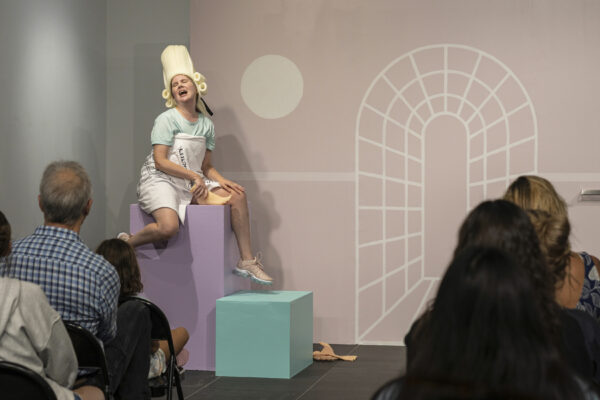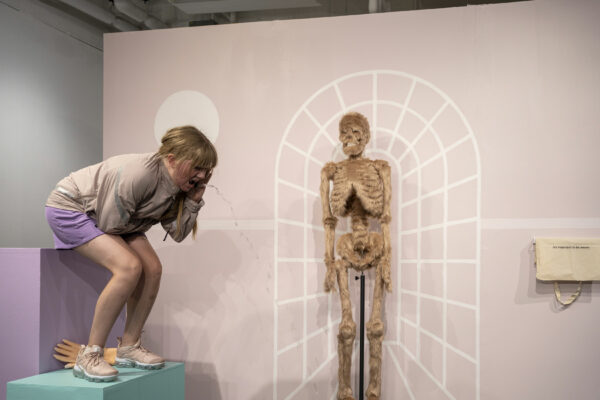There’s something interdimensional about Toronto-based artist Bridget Moser’s performances. They are rooted in present day social politics — atomized consumer culture, the pathos of whiteness, impotent political rage directed at neighbors and service workers — but, like plenty of good speculative fiction, Moser’s work remains tricky to place, chronologically or spatially. Where and when are these repressed, faux-spiritual characters fondling AmazonBasics silicone fetish feet, or modeling a silkscreened tote bag that promotes unspecified “awareness”?
In late October, watching Moser’s latest work, When I Am Through With You There Won’t Be Anything Left (2022), at the University at Buffalo’s Center for the Arts Gallery, I was alternately reminded of the heartbreaking apocalypses choreographed by interdisciplinary dancer Michelle Ellsworth, the recent dystopian workplace television series Severance, and the near-future Berlin of Elvia Wilk’s acerbic novel Oval, where creative class wonks pinball through the salary bands of a neoliberal purgatory. But it wasn’t a mirthless affair; over the surreal fifty-minute run, the audience guffawed dozens of times. In the same way that Moser’s work cannot be easily placed in space or time, it is disciplinarily perplexing, more abject than most body endurance performance art — and less hacky and sensational — while being as oblique and effervescent as the best sketch or standup comedy.
“Moser’s hilarious, existential and offbeat sensibility about everyday life brings with it a balance of joy and profundity,” Toronto-based curator Anna Gallagher-Ross told me over email recently. Previously, Ross served as Associate Artistic Director at the Fusebox Festival in Austin, where she curated Moser into the 2018 program. “We knew her work would be right at home with our audiences,” Ross elaborated, “especially at a time when day-to-day life in Texas had been rendered strange, on a number of levels.”
When I Am Through With You There Won’t Be Anything Left debuted at the Bemis Center in Omaha, Nebraska, in March, as part of the group exhibition I don’t know you like that: The Bodywork of Hospitality, curated by Sylvie Fortin. A University at Buffalo iteration of the exhibition, for which Moser’s recent performance served as a preview, opened in early November. And in August, curator Rebecca Marino brought When I Am Through With You to the Texas State Galleries in San Marcos, where Moser found a particularly attentive audience.
Following her event in Buffalo, I caught up with Moser to talk about props, how the pandemic shaped When I Am Through With You, performing in Texas, and the importance of playlists on her process.
Sean J Patrick Carney (SJPC): The staging for your latest performance, When I Am Through With You There Won’t Be Anything Left (2022), is innocuous, maybe even borderline cute. There’s a millennial pink wall, adorned with a minimal geometric arc, flat moon, and hanging towel bearing a modified tree of life, as well as a few simple plinths in mauve and mint green. What kind of tone are you intending to establish?
Bridget Moser (BM): It’s meant to feel like a set, but one that’s confusing, slightly-off — is this a bathroom or a landscape? It’s both, by the way. And the plinths point towards a stereotypical gallery exhibition strategy, except they’re in these non-neutral, annoying colors and sit empty. All of the objects I use in the performance — aside from the towel — are hidden, waiting to be activated. It should feel, as you say, innocuous, to the point of being superficially calming, but also perplexing.
SJPC: There’s a wild dissonance between those New Age-flavored, twenty-first century pastel graphic design tropes and the work’s title, which is essentially a threat.
BM: What you’re describing sums up a friction I always wrestle with. In my head, I wish my work was frightening, disgusting, but then in execution it feels softened by levity, gentleness, or cuteness. In the first sequence of When I Am Through With You, for example, I’m hidden behind the wall while a deep computerized voice warns the audience to “get ready” because “it” is about to happen. The voice repeats variations of this for more than a minute, which is both irritating and, I think, sort of funny. I suppose that’s the tone I’m trying to establish in the beginning: mildly awkward and lacking substance, with a veneer of calming, largely meaningless pastels.
SJPC: Is the title directed at your audience?
BM: Not exactly. I borrowed it from a line in the theme song to the 2007 television series Damages, a show depicting the consequences of two women’s ruthless ambitions, and, more broadly, the cruelty inherent to pursuing power and wealth. The “you” in the title is me — maybe at times, emblematic of white women more broadly — which, I think, means the “I” is the work itself.
SJPC: The work destroys white women?
BM: That question is predicated on the notion that white women could ever be destroyed, when in fact we have a real tendency to do the destroying.
SJPC: A bulletproof response. I was joking, but actually, when I think about a lot of your work, I realize that I’m only half-joking.
BM: Well, the me who is destroyed cannot possibly be a neutral subject. My performing body is pretty much the one consistent material in my work, and, like the objects I use, its materiality is specific, and it should similarly be open to riffing and ridicule. While in a couple of cases I’m using other white women’s real voices and words, I’m thinking more about how I recognize those compulsions in the ways I learned to experience the world, and, in several other sections, about how whiteness in general creates a highly absurd lens through which to view life.
SJPC: You’re implicating yourself in the critique, which tends to produce a much more complex kind of comedy.
BM: Right. It’s obviously very easy to roast whiteness and have a laugh, but that on its own seems disingenuous when I’m in collusion with and constantly benefitting from it. So there are repulsive and ridiculous moments, but there are also moments of pathos that deal more with loneliness, isolation and total confusion. I want it to be a more comprehensive expression of that incongruous lens.

Bridget Moser, “When I Am Through With You There Won’t Be Anything Left,” 2022. Image courtesy of Texas State Galleries; Photo: Madelynn Mesa
SJPC: There are additional incongruities in the score for the work, a wild sonic tapestry that careens between meditation soundscapes, horror film screams, and nü-metal hits. Someone next to me in Buffalo audibly gasped when System of a Down’s “Chop Suey!” exploded from the speakers.
BM: As they should have. And another man began weeping when Counting Crows’ “Colorblind” started playing.
SJPC: Clearly, you are painting with sound. How do you approach scoring a performance?
BM: Gathering sound is a big part of my process. When I’m building a performance, I’m actively seeking audio that has specific affective qualities for the mood I’m trying to get at. Those qualities might come through lyrically, or tonally. I want to build a confusing world where the Warsaw Philharmonic is as welcome as Limp Bizkit, or the horrible sounds of Shelly, the zombie in The Evil Dead, or the music from Westworld’s wretched third season.
At the beginning of December 2020, I was finally starting to think about performing live again, so I started organizing a playlist that ultimately shaped When I Am Through With You. The chaotic mix likely reflects my psychological state at the time. Some of it is thematically linked, like incorporating the soundtrack to Neon Genesis Evangelion — which itself overlaps with the lyrics to “Chop Suey!” I mean, seriously, do angels deserve to die?

Bridget Moser, “When I Am Through With You There Won’t Be Anything Left,” 2022. Image courtesy of Texas State Galleries; Photo: Madelynn Mesa
SJPC: Does it matter to you if audience members catch that vast spectrum of references?
BM: Not exactly, because whether or not those specific references are legible to anyone other than me, as a score, they operate at important emotional registers that create different senses of weight and lightness throughout the performance. Every piece of audio I sourced or created makes reference to physical bodies or the construction of self.
SJPC: And as you’re animating various props — the silicone feet, the torso inflatable, the fleshy gloves — the soundtrack variably guides or misdirects the audience into fits of laughter or total repulsion.
BM: As I was writing When I Am Through With You, I was thinking about a kind of body horror where the gore is completely contained on the inside — like, more of a horror of interiority. And I found that the more I dug in there, the sequences necessarily became funnier, sadder, more disgusting, scarier, and lonelier all at once. The conceptual template of unseen, internal horror is how a lot of the tensions — visual and sonic — developed.
SJPC: Are the props then external manifestations of the internal horror? They’re grotesque, in that they are basically dismembered body parts, but also totally banal, bloodless.
BM: They’re manifestations of something. I live in Toronto, and even in February 2021, we were still in serious lockdown. When curator Sylvie Fortin initially invited me to produce a performance for The Bodywork of Hospitality’s first iteration at the Bemis Center in Omaha, it had been a full year in Toronto without physical gatherings. So, just like it had with the soundtrack, that horrific context shaped the way that I selected, procured, and modified props. And sourcing the props mid-pandemic, it turned out, would be its own ordeal.
SJPC: Oh god, I never considered the impact of supply-chain disruptions on prop comedy.
BM: Seriously. After deciding that I needed to cover a skeleton with fur for this performance, I had to wait weeks and weeks for the medical model to ship and finally arrive. Then, of course, I needed fabric. Toronto has several great fabric stores in the Fashion District where, normally, I’d spend several hours browsing — I love the process of sourcing props and materials, and I prefer to be able to handle items before committing to them. But the whole city was closed down. So, I DM’ed my absolute favorite fabric shop — shout out to King Textiles — and asked if they’d send me photos of any faux fur they had in stock that might be described as either a blonde color, or something in the range of my skin tone. They graciously sent me multiple images of options. I chose what I thought would work best, walked over, and picked up bags of fur on the curb.

Bridget Moser, “When I Am Through With You There Won’t Be Anything Left,” 2022. Image courtesy of Texas State Galleries; Photo: Madelynn Mesa
SJPC: Comedians typically use props as one-offs or punchlines, but you spend a lot of time with yours, both while performing and — as is evident with the skeleton — as a fabricator. What motivates you to get the extra mileage out of these ridiculous objects?
BM: When I first started performing a decade ago, that was a literal economy of means. I could spend $5 on a plunger and easily bleed out ten minutes of material: it’s a cocktail glass, a bell-ringer, it’s suctioned onto my gut, it’s plunging my face, it’s a baby — you know? That’s a satisfying compositional game. How many modes does one object have, and how can I arrange them into a cohesive, if ridiculous, system of meaning? I usually only use an object for one performance, so I have to give it the attention it deserves. The exceptions to that rule are Crocs and chairs, which appear frequently.
SJPC: You recently performed When I Am Through With You at Texas State University. How was the audience there?
BM: I performed it twice in San Marcos, and we had a pretty full audience at both. And it was quite funny, because people were laughing, but they were also so polite and attentive. I’m up there, towards the end of the piece, screaming about how my body is about to emit a viscous liquid all over their car that will slowly destroy it, and they’re tilted forward, just really listening to what I’m saying. Usually, at that point in a performance, I don’t expect that level of serious engagement.
SJPC: A Texas-sized attention span.
BM: I definitely appreciate it. Afterwards, a few of them approached me — curious people who want to talk about a piece afterwards are the best. In a setting like a college gallery, they’re often younger and nervous that their question or observation isn’t the correct one, but they are always insightful. Where else does a twenty-year-old man walk up to you and start to immediately talk about his emotions? Maybe that’s more common in San Marcos than I think.
SJPC: And that wasn’t your first time performing in Texas.
BM: Right, back in 2018, I did the Fusebox Festival in Austin, which was a terrific experience. Festivals and I have a complicated relationship, but Fusebox has figured out the form. Plus, their programs are free, which is really, really big.

Bridget Moser, “When I Am Through With You There Won’t Be Anything Left,” 2022. Image courtesy of Texas State Galleries; Photo: Madelynn Mesa
SJPC: Will you be performing When I’m Through With You again?
BM: It will return to Buffalo on April 6, and later in 2023 it will go to Lethbridge, Alberta, which is sometimes considered the Texas of Canada. In the past, I haven’t performed the same long-form work more than maybe twice at most, so it’s been really nice to get to know this one so well. Hopefully that will continue.
SJPC: Can you tell us what’s on your working playlist for your next piece?
BM: Okay, but I need to preface this by saying that this is an extremely preliminary collection; many will not make it to the final round. Eighty percent of the songs I gathered for When I Am Through With You, for example, never found a home in the performance.
So, that being said: Mozart’s “Requiem in D Minor”; “Lightning Man” by Nitzer Ebb, which I have longed to use since 2013; “You & Me – Flume Remix,” a song I like to cry to while running; “The Prayer” by Céline Dion and Andrea Bocelli; “Rest in Peace,” the Undertaker’s theme song from the WWE; a song called “Cbat” — if you spend time on Reddit, you may be familiar; and, for some reason, “The Boxer” by Simon and Garfunkel.
SJPC: You know, I’m sorry, I should have said this earlier: no, I don’t think angels deserve to die.
BM: That’s what I’ve been trying to say.
********
I don’t know you like that: The Bodywork of Hospitality, curated by Sylvie Fortin, is on view through May 12, 2023 at the University at Buffalo’s Center for the Arts and Anderson Gallery in Buffalo, New York. Moser will perform When I Am Through With You There Won’t Be Anything Left on April 6, 2023 at the UB Center for the Arts.


